To paraphrase Madonna, we are living in a digital world. If you are not experimenting with different digital marketing mixes, you probably aren’t reaching all your potential customers.
If you are serious about remixing your digital marketing mix, take a look at these 12 strategies. You may recognize some of them but now is the time to consider which ones could be helpful to your business as the world becomes ever more digital.

Let’s be honest. Twelve seems like a lot of strategies for a “best of the best” list. Most of these lists have five suggestions, 10 at the most.
But hear us out. Not every digital marketing strategy will work for every business. If we only gave you five or even 10 choices, you may not find the best fit for your business.
So without further ado, here are our choices for digital marketing strategies for 2020 and beyond.
This is the hottest trend in marketing. Video is attracting more and more users every day and has become the preferred way for mobile users to engage with content. If you want to add video to your marketing mix, keep your videos short, and keep them engaging. Video series work great for this. One idea is to break a case study up into small chunks with a cliffhanger at the end of each segment. If you want to see how we do video, check out our YouTube channel.
SEO is still one of the most important marketing strategies to have in your digital mix. An SEO expert can help you master this strategy as it is a hard one to master on your own. One thing to know in this area is that Google is changing its security requirements for pages, and those that aren’t in compliance will not be ranked as highly. They are now asking that websites that ask for contact information carry an HTTPS format, which is more secure than the traditional HTTP.
Related reading: SEO Seattle
SEM stands for Search Engine Marketing. You may also know it as “pay-per-click.” This is another area where an expert can help you dial in the best strategy for your business. If you don’t have the budget for an expert, Google AdWords and FacebookAds have great tutorials and analytics dashboards that can help you learn the basics and experiment as you go.

One of my favorite statistics about local SEO is that 78% of mobile users who conduct a local search on their phone end up purchasing from a physical location. 18% of those users conduct that purchase within 24 hours. A good local SEO strategy is a great way to increase foot traffic and attract more local customers.
Featured Reading: Local SEO is Crucial for Service-Based Companies
Creating landing pages is a great digital marketing strategy, but it only stays a great digital marketing strategy if you keep them updated and optimized. It’s important to monitor activity on your landing pages just like you do on your main site. That way you’ll know when and what needs to be tweaked to bring you better results.
We’re all on Facebook. Lots of us are on Instagram and LinkedIn. There are so many opportunities for you when you embrace a social media marketing strategy. This strategy is a great way to engage with your audience and build a loyal following. However, it will only work if you are committed to posting engaging content regularly. There are lots of great automation tools that can help you accomplish just that. (More on that later.)
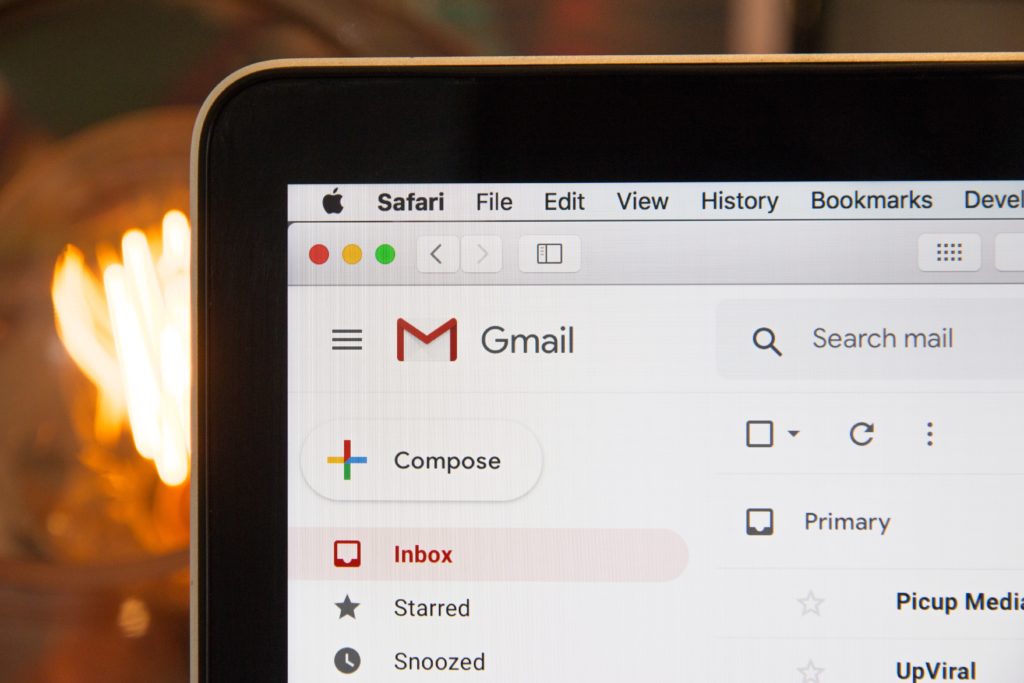
Email marketing is a great addition to any digital marketing strategy. It’s great for repurposing content, offering clients exclusive deals, and integrating your other marketing efforts. You can also do it for free, or for a very low cost using third-party platforms. If you are collecting emails on your website, be sure you are using an HTTPS form. (See Strategy #2: SEO.)
The goal of this strategy is to establish yourself as an expert in your field and be a go-to resource for your clients looking for information. A content marketing strategy is a great complement to an SEO strategy as search engines love websites that have regularly updated content that is reliable and valuable to searchers. You are also able to repurpose this content into lots of other forms including emails and videos.
Influencer marketing is working with influencers in your field to promote your product or service. Most influencers will require a fee for this promotion, although some will do it just for a free product. It’s important to note that we’re not talking about Kim Kardashian level influencers here. There are lots of influencers who are not celebrities but who have a lot of, well, influence over their audience. To find the right influencer for your product or service, search the hashtags related to your field and see who your audience is following and listening to.

Just because someone leaves your website without taking action doesn’t mean they aren’t interested in doing business with you in the future. Remarketing, or retargeting, ensures that your business ads stay in front of their eyes on other websites. This keeps you at top of mind and raises the probability that they return to you for their final purchase.
While this is less of a marketing strategy than a web design best practice, it’s key to ensuring the success of your other marketing efforts. The majority of consumers are visiting websites on their mobile devices. If your site isn’t able to be viewed, or is hard to navigate, from these devices, you will lose customers faster than you think.
Featured Reading: What Does Responsive Web Design Mean?
Everything from your email to your social media marketing efforts can be automated with amazing effectiveness. Finding which of your marketing practices can be automated, and then automating them, will save you time and money, while also increasing your marketing efficacy.
Don’t feel overwhelmed. You don’t have to immediately implement all 12 of these strategies to see a return. These are just suggestions for strategies you can add to your digital marketing mix to kick everything up a notch. However, it is important that you are regularly updating your marketing strategy to find the best combination for your business.
—
Thrive Design is a customer-centric web design and marketing agency from Seattle. Contact us today to find out how we can elevate your business online! Find us on Clutch, UpCity, LinkedIn, Facebook, and Twitter.
Your website design is only as good as the leads it brings in. If it isn’t offering valuable content in exchange for a potential lead’s email, you’re leaving money on the table.
That’s the subject of my sixth step for online domination: finding your killer offer.
See Related: How Do You Announce a New Website Launch?

Your killer offer is a valuable piece of content you create that will entice potential leads to enter their email addresses in return for being able to access that content.
For example, I design and build amazing websites that get results for businesses. So my killer offer is a downloadable PDF that outlines the five things you need to know before embarking on a new website project or hiring a website designer.
(In fact, if you’re curious about what five things you need to know before starting a website project, check out the sign-up form in the sidebar of this page. 👉)
Your killer offer could be anything from a YouTube video to a short e-book to a case study or a checklist. Whatever it is, it should either be something that cannot be found by browsing your website or should contain expanded content from your website.
Basically, it should be something special that they can only get by giving you their email address.
Bonus: How to Add a New Website to Google Analytics

Deciding what to offer as your killer offer can be tricky, but it doesn’t have to be complicated or time-consuming. There’s probably even content waiting to be repurposed into your killer offer on your website already.
Have you done a series of blogs on the same topic? Package them together in a short e-book.
Are you a fan of the listicle format and have a bunch of those? Pare them down and turn them into checklists with actions people can take to reach a goal.
Do you have a go-to list of resources in your industry? Create an email or document that explains why you love them and links out to them and publish it as a “Definitive Guide to My Industry.”
Take what it is that your clients come to you for and give a taste of it to your leads for free. THAT’S the best way to find your killer offer.
The key to creating a killer offer that converts is to avoid making it a hard sales piece. The best killer offers are those that position you as an expert in your field, that show your potential clients that you know what you’re talking about.
(If you still need help brainstorming ideas for the format of your killer offer, HubSpot offers some great ideas in this piece on lead generation ideas.)

Now that you’ve created your killer offer, it’s time to create the follow-up on your killer offer. There’s no use in generating great new leads who are clearly interested in what you have to offer if you don’t have a plan to cultivate them.
In my case, signing up to receive my short e-book on creating a winning website triggers an email sequence that sends five emails over the course of two weeks. These emails further position Thrive as the right company to work with on their website project.
We’re not trying to sell them. We’re trying to educate them more about us so that, when the time is right, we’re the ones they think of when they’re looking for a web design firm.
That should be your goal too. You’re not selling in these follow-ups. You’re educating.
Here are some questions that your killer offer follow-up could answer:
A killer offer doesn’t have to be elaborate. It doesn’t have to be 100% unique. It doesn’t even have to be that long.
What a killer offer needs to be is relevant, valuable, and useful for your potential clients. It needs to demonstrate your expertise in a way that will stick with them. And, most of all, it needs to be prominently displayed on your website.
Don’t keep leaving money on the table with a website without a killer offer. Now is the time to start cultivating those website visitors that want to get in touch but aren’t looking for the hard sell. They need your killer offer.
The Irresistible Offer is only one of the elements we've identified as necessary for dominating online. To read more about how to create killer websites, check out our Blueprint for Online Excellence.
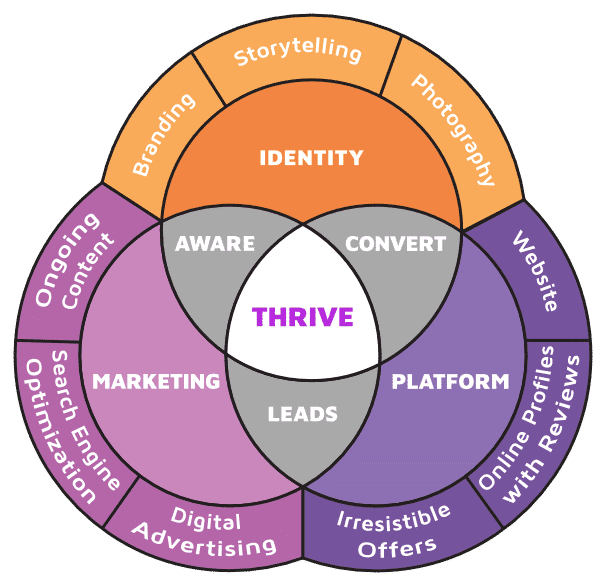
Keep Reading: How Long Does it Take for a Website to Show Up on Google?
—
Thrive Design is a customer-centric web design and marketing agency from Seattle. Contact us today to find out how we can elevate your business online! Find us on Clutch, UpCity, LinkedIn, Facebook, and Twitter.
Category: Web design seattle
As helpful as Google Analytics is, it can be one of the least user-friendly tools in your arsenal. It’s even tricky for some experts to figure out all the ins and outs at first.
Thrive's web design agency has your back. Our step-to-step guide to adding a new website to your Google Analytics will help you ensure that all of your web properties are in one easy-to-access dashboard.

We love a good step-by-step how-to especially if there are pictures involved.
This step is pretty straightforward. Hopefully, you can even skip this step if you visit frequently enough to have your login information stored and ready to go.
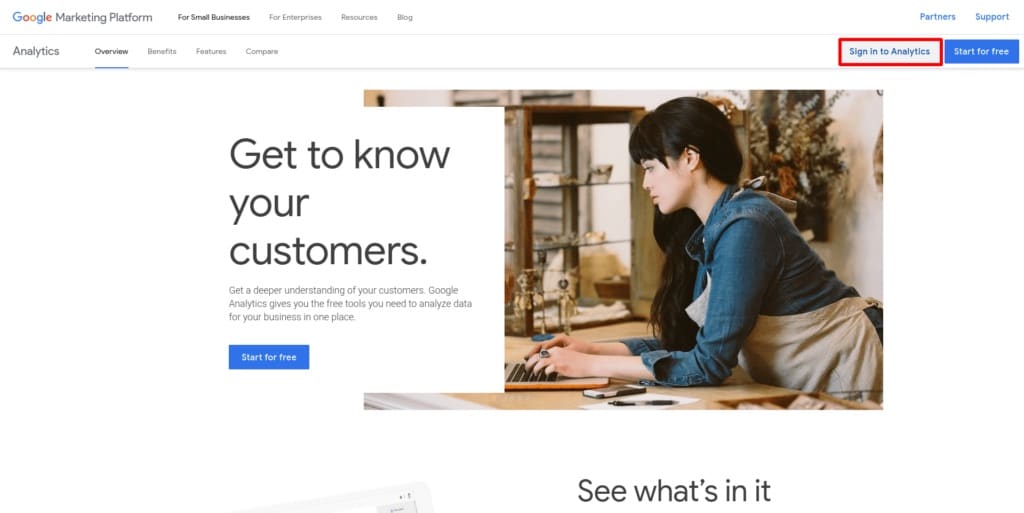
In the newest version of the Google Analytics dashboard, the Admin button is somewhat hard to find. It’s slightly buried at the bottom of the left-hand side of your dashboard.
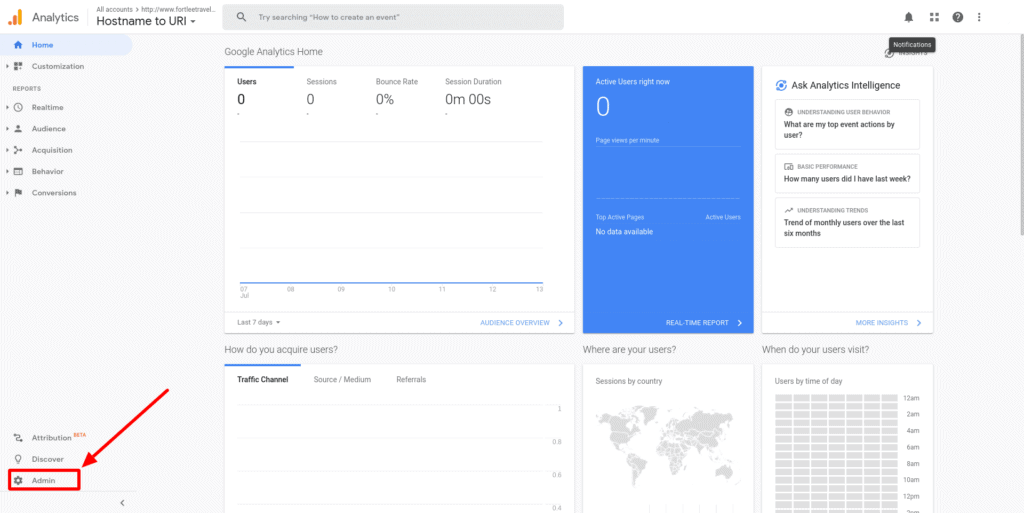
If you need to create a new account, there are a few steps you’ll need to go through to make sure it’s all set up. You’ll need to make some choices about what you want to measure and what data you want to share with Google.
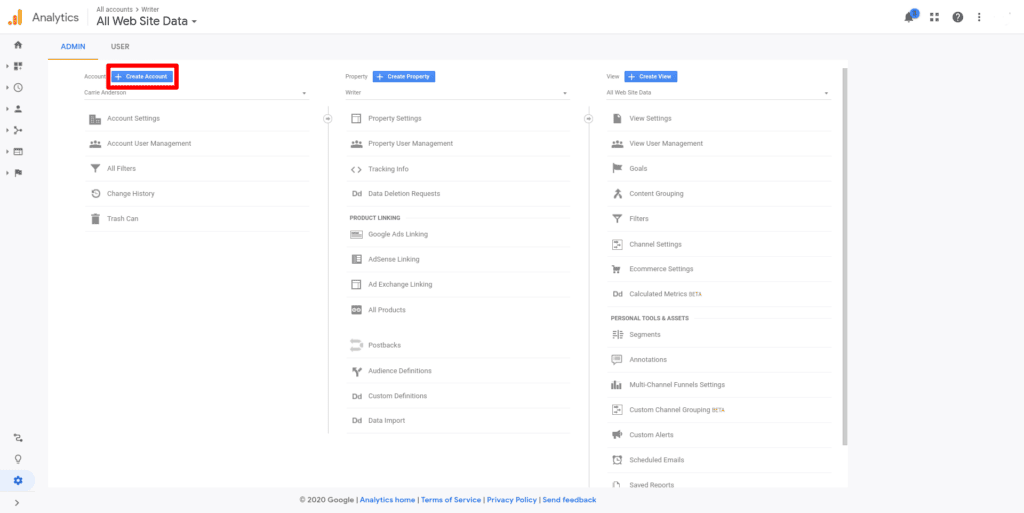
Again, you’ll need to choose what you want to measure: your website, an app, or both. Once you make those choices and add in your web address, you’ll get your analytics tracking code, along with all you’ll need to add the analytics into your website’s code.
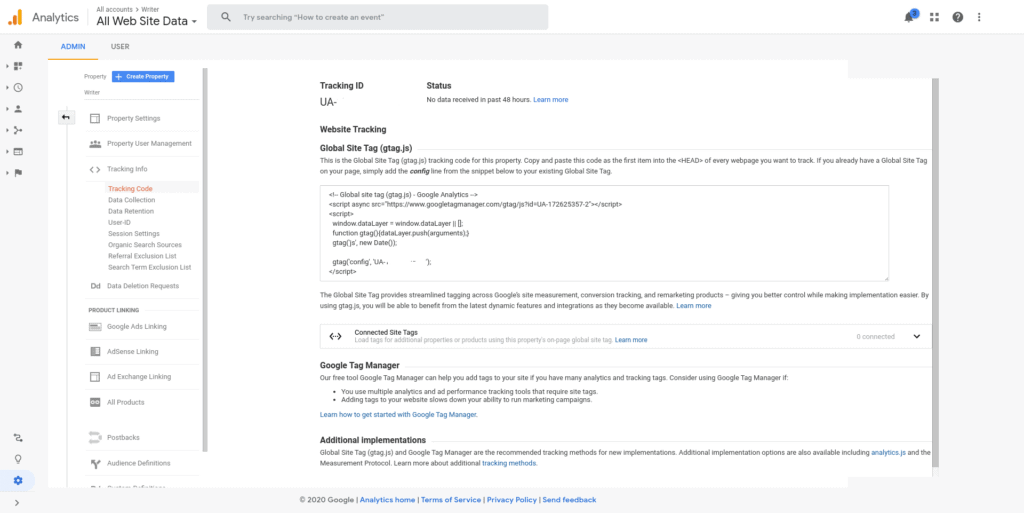
See Related: How Long Does it Take for a Website to Show Up on Google
Data is king. And Google Analytics is the king of data.
When you need information about how websites are performing, Google Analytics is where you should turn for the most accurate, most up-to-date, most robust (and FREE) trove of data. By keeping your GA account updated with all of your webpages, you ensure that you are getting all of the best information you need to keep your website performing at its best.
With Google Analytics you can:
Bonus: The 6 Best CSS Frameworks for 2020
Don’t let the sometimes confusing interface deter you from taking full advantage of all that Google Analytics has to offer. Drop a note in the comments and let us know if you have any more questions or want other Google Analytics step-by-steps.
Keep Reading: How Do You Announce a New Website Launch?
—
Thrive Design is a customer-centric web design and development company from Seattle. Contact us today to find out how we can elevate your business online! Find us on Clutch, UpCity, LinkedIn, Facebook, and Twitter.
Category: Web design seattle
Every website is different. An e-commerce site is not a landing page is not an authority building page.
But. (And this is a big but.)
There are certain essentials that all websites need to have in order to be successful and achieve your business goals.

As you peruse this list, you may notice that none of the items listed could be considered “groundbreaking.’” But that’s the thing about essentials.
They aren’t trendy. They never go out of style. And they’re sometimes easy to overlook in favor of the new, hot trend. We’ve noticed, however, that the websites that have a solid base of essentials perform way better than their trendier counterparts.
So how many of these essentials does your website boast?
If you’re a regular reader, you’ll know that I have a thing for speed. My favorite statistic about websites is that if it doesn’t load in 3 seconds or less, your visitor is moving on to your competitor. Speed is essential for your first impression and it can say a lot about your business. Visitors tend to view slow websites as unprofessional, annoying, and not as secure as quicker sites.
So take the time to compress your images, evaluate your plugin use, and ensure there’s no loose code anywhere that’s slowing down loading speeds. (You can also check out our article on why your WordPress site may be running slow for more tips and tricks.)

More than 33,000 websites are hacked every day. Not all of these websites are big-name companies with loads of data for hackers to steal. Most of them are small- to medium-sized businesses like yours. There are bots that work day and night to search out and infiltrate vulnerable sites.
They target these sites in order to steal customer information, send out spam, or use your website to distribute malware to your visitors’ computers. Just because you’re small, doesn’t mean you’re not a target. We’ve got lots of things you can do today to ensure that your site doesn’t become the next target.
75% of visitors to your website are making their initial judgment of your business based on the look of your website alone. Fortunately for you, website design is not the same as fashion design. While people can disagree about aesthetics all they like, there is a surprising about of consensus about the fundamentals of good design. Easy navigation. Easy to find contact information. Good usability. (Professional photography and content don’t hurt either.)

People like to be entertained as they are informed these days, even when they’re shopping for goods or services. Your website content should give them just that. It should be easy to read and understand, well-organized, and, ideally, keyword-optimized so Google knows it’s there (see Essential #7 for more on this). If you have a knack for copywriting, that’s great! If you don’t, you may want to consider investing in a professional copywriter to revamp or rewrite your site.
This one is tricky. A few years back, having your social media feeds directly on your website was all the rage. Please don’t think we’re advocating for this. Those feeds slow down your website significantly and make your design look clunky and outdated. However, you should have links to all of your social media properties on every page of your website, especially if you update them frequently, and vice versa.

In the early days of the internet, finding a great domain name was easy. Pets.com. Care.com. Think.com. You were able to easily choose a domain that encapsulated your brand and product offering. It’s a little trickier these days with literally billions of websites, and more created each day.
However, it’s important that your customers are able to easily remember, and easily access, your website. That means no including numbers for letters or any other clever spelling tricks that get you the name you want but sacrifices your customers’ ability to get there. You may have to think outside the box.
Take our domain, for instance. There is, obviously, already a Thrive.com and we didn’t want to limit ourselves geographically by putting our city in the domain. So we went outside the .com genre and claimed thrive.design. Clear, clever, and impactful. The perfect domain name.
None of the changes you’ve made to speed, design, copy, or security will matter one bit if your customers and potential customers can’t find you. That’s where Google comes in. (Because, let’s be honest, who uses Bing?) If you’re not showing up on the first page of Google search results for key words or phrases that impact your business, customers are not finding your website.
Good SEO is more than stuffing your website full of keywords and hoping that it ranks higher. (Google actually docks you points for that SEO tactic these days.) Regularly updated, relevant content is actually the best way to improve your SEO rankings. You also need to ensure that your metadata and tags also include the keywords you are trying to rank for, a much-preferred method to keyword stuffing.
Also, don’t forget about Local SEO.
Related reading: SEO Seattle

(Ok so we ran out of Ss here. It was a good run though.) Your website’s visitors need to know what you want them to do. Do you want them to sign up for an email? Do you want them to schedule a consultation? Do you want them to find the perfect product for their needs?
A website that doesn’t lead its visitors to action is a website that isn’t performing as well as it could be. Using clear calls to action and a defined sales funnel is a great way to convert more visitors to customers.
Your customers aren’t just browsing your website on their laptops or desktops. They’re browsing your website on their phones and tablets too. Your website should be just as beautiful, just as easy to navigate, and just as fast no matter what device your customers are using. This is called responsive design.
Customers looking to buy locally are going to be turned off immediately by a poor browsing experience on their phone. Clunky navigation and slow speeds are a fast way to lose mobile customers. A quick way to check if your website is responsive is to log on from your own tablet or mobile device. If you’re unhappy with the browsing experience, your customers are too.

Your website is an extension of your brand, and that should be reflected throughout the site. Your logo should be prominent. Your brand colors should be used strategically. The tone, look, and feel of your website should match the tone, look, and feel of your other marketing elements. Your customers should be familiar with your brand. If they don’t get the same brand experience, they won’t trust that your website is...your website. If you don’t have a brand yet, you can check out our branding, website, and marketing primer.
The great thing about essentials is that they don’t go out of style. If you focus on dialing in these ten things, you are guaranteeing your website visitors a great website experience for years to come.
—
Thrive Design is a customer-centric web design agency from Seattle. Contact us today to find out how we can elevate your business online! Find us on Clutch, UpCity, LinkedIn, Facebook, and Twitter.
Category: Web design seattle
Many marketing pros and small business owners dread facing the Google algorithm, the Internet monster that places websites in its organic search results. If your web designer just finished your new website, and you’re wondering how long it takes for a website to show up on Google, follow these pro tips to turn the monster into a supportive friend.

As you add your new website to the multitude of sites on the web, Googlebot searches through the vast Internet to fetch web pages. The bot is often called a spider, and the bot is crawling around, looking for and fetching the content.
Next, the fetched pages are indexed in Google so that when someone searches with a word or set of words, all web pages that contain those words are pulled up into the results.
Bonus: How Do You Announce a New Website Launch
The Google processes of crawling and indexing can take days or weeks to find your web pages and place them in line for an organic search. You can’t provide a deadline for Google, and you can’t predict with certainty that it will be 5 days or 25 days before you find your site on the results pages.
The good news: Your business is not totally without influence on obtaining results status as you can implement certain practices to help Google to find and index your pages more quickly.

Google can use a bit of help with knowing that your site exists. Knock on the door and asked to be let inside by creating a sitemap, an XML document, and submitting it to the Google Search Console. You can also submit individual pages URLs. Submitting the sitemap says to Google, “Hey, here I am. Feel free to look around.”
A second way to let the Google engine know that you exist is to turn on Google Analytics. It’s will be your tool to analyze your success, but, in this case, it sends a signal to Google that your website exists. Both tactics could speed up the indexing process.
See Related: How Much Does It Cost to Redesign a Website?
Links to your site could be the golden pathway to a quicker Google listing. You might think that you need a listing to get traffic to your site, but it works both ways. Google will notice if your site gets a lot of activity that comes from placing links in your Tweets, Facebook posts, Instagram posts, blog posts, emails, online directories, and on the sites of others who share the excitement about your brand.

No one wants to be on a website that doesn’t have great information, well-written content, and good quality images that are consistent with your brand. Neither does Googlebot!
Use SEO practices, including meta tags and short- and long-tail keywords, and alt text on images to aid the spiders behind the scenes. The spiders find well-designed, good content more easily, making a faster listing a possibility.
Related reading: SEO Seattle
Did you know that poor design can block Google from finding your site? That would be a disaster. Be careful to not leave code in that tells Google to not crawl your site, often used during development.
Fix robots in the coding that, while intended to keep the crawlers out of certain parts of the site, unintentionally block the content you want to be searched and indexed. Also, check your links regularly and make sure they’re unbroken. Keep your design error-free for the best search possibilities.
See Related: The 6 Best CSS Frameworks for 2020
We’re not talking about the famous Whitney Houston song here. How do you know if your site is indexed on Google? Go to the Google search bar and type in site:(yourwebsite.com).
You’ll find out if your site is indexed and how many pages are included. Indexing gives you the first part of the listing equation, although It doesn’t guarantee that you’re listed yet. New sites take time to index and, as you may know, waiting requires a great deal of patience.
The Google algorithm is your friend.
If you do nothing but create a website, don’t expect a quick trip to the search results. It’s worthwhile to put your efforts into the best practices that make your site more easily findable. It turns the Google algorithm monster into a supportive friend that works for you and your website. Once your site is listed in the results, keep up with your efforts to keep your site listed and work on raising your site higher in the rankings for greater visibility.
Keep Reading: How to Move Your Website to a New Host
—
Thrive Design is a customer-centric web design agency from Seattle. Contact us today to find out how we can elevate your business online! Find us on Clutch, UpCity, LinkedIn, Facebook, and Twitter.
Category: SEO Seattle
Local SEO is a set of techniques used to get you more traffic in your local area. This is the most important type of SEO for services that target a specific area for their services such as plumbers that service Bellevue, Redmond, and Kirkland or Construction companies that only service Seattle.
Some common Local SEO techniques we employ include:
Facebook, Yelp, and Google My Business profiles that contain full company details, compelling photos of the business/services, events, and plenty of real reviews from customers.
Consistent NAP (name, address, phone) information across the web on reputable websites and on your own website.
Inbound links to your website from websites also serving your target areas such as local associations, industry organizations, and local directories.
Writing relevant content on your website for what your company is doing in your community, events you participate in, and other ways you serve your community.
Coding your website with local relevant terms for the area you are targeting including alt tags, metadata, and local business schema.
Having a website that loads quickly, is mobile-friendly, looks professional, and is easy to use. Google knows when visitors to a website visit and then immediately leave.
We stay up to date with the latest trends in local SEO and have found a good local SEO campaign can create drastic improvements to your website traffic.
That being said, we require our Local SEO clients to have a website that is professional, quick to load, mobile-friendly, and easy to use. There is no use sending people to a website that doesn’t have these attributes just like we wouldn’t send people to a brick and mortar store unless it had products on its shelves, was clean inside, and had friendly staff.
—
Thrive Design is a customer-centric web design and marketing agency from Seattle. Contact us today to find out how we can elevate your business online! Find us on Clutch, UpCity, LinkedIn, Facebook, and Twitter.
Many small businesses, even established ones, don’t know where to start when it comes to branding, website creation, and marketing. They do not have an internal department to handle these activities nor the time/knowledge to do it themselves.
The purpose of this article is to define Branding, Web Design, and Marketing and to put them in the correct order in which they need to be performed.
In fact, let’s do that right from the start.
If you want to be successful with your business understanding the roles of branding, website creation, and marketing is essential.
The first thing you need to do is establish a brand for your company.
Whenever you think of a company or a product, its name, logo, packaging, slogans, spokespeople, and identity are the first few things that will come to your mind. These things are collectively called the branding of a company, business, or product.
Ideally, your branding has been created so that anyone interacting with your brand feels certain emotions.
For example, if you are creating branding for your plumbing company it would be a good idea to elicit competence, trustworthiness, security, and reliability. After all, if you had a broken pipe you want someone who makes you feel secure and that they are reliable, trustworthy, and will get the job done.
Be warned, your company is going to fall on its face if it does not live up to your branding. Solid branding can not make up for breaking the promise of your brand.
Branding starts with your company name, slogan, colors, fonts, and logo.
Branding is the baseline for your website’s design and the first step in having your target audience be aware of who you are. If done correctly, it will help people distinguish you from the other similar companies and products by highlighting your services and presenting you in a positive light.
Successful branding presents your company as a better option than your competitors by promoting your best features. It builds your reputation among the targeted audience and dwells in their subconscious.
If you want to be successful online you must invest in your company or product's branding.
Following are the few things that will tell you why branding is the first step in the service order for your company:
A company without a reputation and characteristics features to promote will find it challenging to earn recognition for itself. There must be a name, a logo, a motto that is pushed through publications and advertising to make you stand out among the masses.
It is recommended to make your company’s logo easy to remember, and its name easy to roll off people's tongues. It should be something that should stick within the minds of the targeted audience.
We recommend testing a company’s name with your target audience. There are basic questions you can ask to make sure they are not confused about what you do and to make sure they can remember it after only a few mentions.
Impactful branding makes people aware of your company’s services at a glance. The more people are aware of your services and products; the more likely they are to lean into the sense of familiarity at times of need.
There is a sense of dependability that can be established once people are aware of what your company represents.
A well-thought and elaborate branding strategy present your company and product as trustworthy in the marketplace.
The more professional you appear in front of your potential customers, the more likely they are to trust your company and services.
Branding your company and product will help you advertise or market it better in front of the audience. You will have a logo or name that you can use in your marketing campaigns and promotional material to spread awareness and build trust among the audience.
Most advertisements follow a specific color theme or target people from a particular background to promote their services, and all of that is predetermined by branding.
If you decide to skip or invest too little in branding your company, brand or product, the next two steps in your process Website Creation and Marketing will be drastically hindered. You won’t be able to establish trust between you and your potential customers as people will find it hard to rely on a nameless brand.
Without branding, people won’t know what to expect from your company and product. They also won't understand why they should choose you over your competitors that- unlike you -have invested in a professional branding strategy.
Branding is an effective way to tell people who you are, what you stand for, and what you want to promote as a company. It reveals your company’s immediate intentions as well as long term goals to let your audience know where you are headed as a business.
Without branding, you will find it hard to devise an effective marketing strategy as well as the theme of your website.
For the last 10+ years, almost every company that has wanted to thrive needed their brand online in order to be successful.
Once you brand your company, the next order of services should be the creation of its website. If you skip this step, then you are bound to lose business opportunities and potential customers.
A website is a 24/7 sales tool. It helps your business grow by making your company or product’s information easily accessible to the audience all around the world.
A professionally designed website with messaging that speaks to your targeted audience can bring in major business. The problem most companies run into is they don’t invest in a website that actually converts. They cut corners everywhere and then wonder why the leads are pouring in.
The website extends your branding and it is the place where many users make their final decision whether to reach out to you.
90% of people do research online before hiring a company. Your website allows them to make sure your services match up with exactly what they need. You need to showcase your best portfolio of services and products with professional copywriting and a design that compels the user to act.
Your company's logo, name, and messaging all determine how you want the world to perceive you. After branding, your website is the advocate of your image and must present only the best version of you.
Even if you skip branding, you'll have to brand your website by creating a logo, name, and design for marketing purposes.
You might be short on funds and want to skip the process of branding, but sooner or later, you'll have to consider branding your company, business or product. It might be hard to digest, but there is no way of marketing your business without branding it first.
As stated earlier, branding determines who you are and who you will be serving with your services in easy to grasp concepts and words. If a prospect can’t find the answers to their basic questions regarding your services, then your investment in branding and website creation all mounts to null.
After all why send people to a website that does not convert? You will only be wasting your money on your halfhearted efforts.
This is where most companies fail. They hire companies that are very inexpensive that don’t spend the time or don’t have the skills to properly brand your company and create a website.
And then… they fail to market it at all.
Marketing through promotional materials and advertising is the final step. Many people will mistake marketing with branding and vice versa, but there is a significant difference between the two.
Branding initially is a brand's identity, and marketing is when that identity is used to spread awareness about a company or product via different tools of communication. The terms are so interconnected that it isn’t surprising if people can't tell where branding ends, and marketing begins.
Marketing evolves with the means of communication and advancement in promotional techniques. Whereas branding can’t be changed as frequently as marketing and most companies prefer to stick to their identity for years to come.
The purpose of marketing is to let people know about the services that you are offering and how it will benefit them in the long run. There isn’t a fixed formula to market your company or brand, and you can either be humorous, serious, or professional while promoting your business.
There are various ways to market your brand, but the most effective way is the one that speaks to the pains and desires of the targeted audience. A marketing strategy with all its intents and purposes aims to bring forth results in terms of sales and profits.
A marketing strategy is the most effective when it is built upon the already established perception of your company and product by your branding. It can not differ from your branding as it will create a drift between who you are and what you are promoting and will make people lose their trust in your brand.
Marketing without Branding
A product or company’s marketing campaign must be consistent in its digital assets but not in its means.
Consistency in your marketing strategy might seem unnecessary, but when you promote your company's identity, then the core values should remain the same. If you don't pay mind to this small detail, then you’ll be developing a campaign that will be riddled with conflicting facts and values, making your targeted audience confused and question your credibility. A lot of this happens in the subconscious. Consistency and simplicity are many times more powerful than complicated and varied messaging.
As noted earlier, branding is an attempt to elicit certain emotions when interacting with your brand. Without branding, your marketing will lack an emotional direction and won’t connect with your audience.
When you hire a marketing team, they will want to know what values you want them to promote as well as what goals you want to achieve through your marketing campaign. All these things are planned during the branding process and should be adhered to strictly while planning a marketing strategy.
Branding defines what your targeted audience is along with your long- and short-term goals. A marketing strategy that follows the direction set by branding is likely to bring in more conversions as compared to the one without it.
Marketing without a Website
A digital ad is only useful when it leads a viewer to your website for them to learn more and take action. An ad has limited space to promote only the core values of your idea, and the rest is the responsibility of your website that entails converting a lead into a customer.
The content you put up on your website determines whether a lead converts into a customer or not. For this, the design of your website page should be attractive and engaging enough to hog even a casual viewer’s attention as well.
Written content, explainer videos, and interactive graphics are the few things that play a crucial role in the success of any sales funnel. That is why one must hire the most competent and professional team to create their business’ website.
Another purpose of a marketing campaign is to make your product or company the talk of the town. It does so by employing techniques of SEO (Search Engine Optimization), writing gripping content, and dealing in referral articles with different sites.
Social media is one of the most popular ways of creating a buzz about your company and product. The more people talk about you, the more successful your marketing strategy will be. But if you don't have a website, then all that buzz will be for nothing as people won’t know where to direct their curiosity.
Believe it or not, a website allows you to track the return on your investment. It can tell you exactly how someone came to you that filled out your contact form, newsletter, or called you. You can figure out how long it took for a visitor to use your services, what made them lean towards your services, and what pages attracted them the most by calculating a lead’s stay on individual pages.
Branding, website creation, and marketing all have a particular place in the service order of any company or product. If you skip or invest too little in any of these steps, your business cannot succeed online.
For instance, without branding your business, you will find it challenging to design your website as well as plan an effective marketing strategy for it. Similarly, without creating a website for your business, your marketing strategy will struggle to meet the demands of digital advertising.
If you want to be successful as a business follow the correct order of services for your company, branding, website creation, and marketing. While you are at it, try to spend optimum time and efforts in making them a success because a halfhearted investment is the same as no investment at all.
—
Thrive Design is a customer-centric web design and marketing agency from Seattle. Contact us today to find out how we can elevate your business online! Find us on Clutch, UpCity, LinkedIn, Facebook, and Twitter.
You have a website but the content hasn’t changed in several months, maybe even years. Google stops to care as much about your website when this happens so let's change it!
First of all, ask yourself why someone would come to your website and what end result you'd like from their visit. For most of my clients, they offer a service and web users are coming to the website to find that service. Their goal is to turn those web users into paying customers.
Get rid of staleness by adding content to your website that draws in the user to have them contact you. Most people need to be sold… and sold quickly. Giving them something for free works wonders. (For example, the guide at the bottom of our web design page).
If you are a plumber, give them an article such as “5 things to do before calling a plumber about a leaky faucet.”
If you are a housecleaner, give them an article “How to prepare for a housecleaning.”
This kind of content shows you as a thought leader in your industry and that you are putting forth good energy and will be helping them out. (When you do this, make sure it’s a blog post with its own page so that Google can send searchers to it when they type in the relevant search terms.)
Beyond regular content that gives useful tips and free advice, be sure to have your contact information prominently displayed in your header. If you offer a free consultation, have a Call to Action button for this above the fold on your homepage (or better yet in the header). For my business, getting clients on the phone is of the utmost importance.
You need your customers to find your website. For your customers to find your website, Google needs to know you are offering new, fresh content that searchers care about. The three steps we recommend to accomplish that are:
—
Thrive Design is a customer-centric web design and marketing agency from Seattle. Contact us today to find out how we can elevate your business online! Find us on Clutch, UpCity, LinkedIn, Facebook, and Twitter.